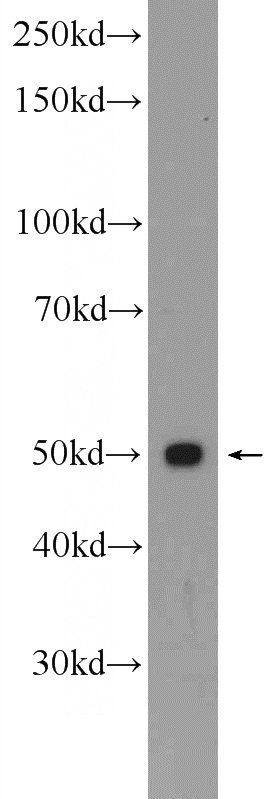-
Product Name
SEPT6 antibody
- Documents
-
Description
SEPT6 Rabbit Polyclonal antibody. Positive WB detected in Jurkat cells, K-562 cells, rat brain tissue. Positive IP detected in rat brain tissue. Positive IHC detected in human cervical cancer tissue. Observed molecular weight by Western-blot: 50 kDa
-
Tested applications
ELISA, IHC, WB, IP
-
Species reactivity
Human,Mouse,Rat; other species not tested.
-
Alternative names
KIAA0128 antibody; SEP2 antibody; SEPT2 antibody; SEPT6 antibody; septin 6 antibody
-
Isotype
Rabbit IgG
-
Preparation
This antibody was obtained by immunization of SEPT6 recombinant protein (Accession Number: NM_015129). Purification method: Antigen affinity purified.
-
Clonality
Polyclonal
-
Formulation
PBS with 0.1% sodium azide and 50% glycerol pH 7.3.
-
Storage instructions
Store at -20℃. DO NOT ALIQUOT
-
Applications
Recommended Dilution:
WB: 1:200-1:2000
IP: 1:200-1:2000
IHC: 1:20-1:200
-
Validations

Immunohistochemical of paraffin-embedded human cervical cancer using Catalog No:115120(SEPT6 antibody) at dilution of 1:100 (under 10x lens)

Jurkat cells were subjected to SDS PAGE followed by western blot with Catalog No:115120(SEPT6 Antibody) at dilution of 1:600

IP Result of anti-SEPT6 (IP:Catalog No:115120, 4ug; Detection:Catalog No:115120 1:600) with rat brain tissue lysate 4000ug.
-
Background
SEPT6 belongs to the septins family that are conserved GTP-binding proteins functioning as dynamic, regulatable scaffolds for the recruitment of other proteins. They are involved in membrane dynamics, vesicle trafficking, apoptosis, and cytoskeletal remodeling.SEPT6 also interacts with hepatitis C virus (HCV) NS5b RNA polymerase and NS5b-binding protein ( HNRNPA1) and may play a role in HCV RNA replication.
-
References
- Wei Y, Yang J, Yi L. MiR-223-3p targeting SEPT6 promotes the biological behavior of prostate cancer. Scientific reports. 4:7546. 2014.
- She YM, Rosu-Myles M, Walrond L, Cyr TD. Quantification of protein isoforms in mesenchymal stem cells by reductive dimethylation of lysines in intact proteins. Proteomics. 12(3):369-79. 2012.
- Kim MS, Froese CD, Xie H, Trimble WS. Uncovering principles that control septin-septin interactions. The Journal of biological chemistry. 287(36):30406-13. 2012.
Related Products / Services
Please note: All products are "FOR RESEARCH USE ONLY AND ARE NOT INTENDED FOR DIAGNOSTIC OR THERAPEUTIC USE"
